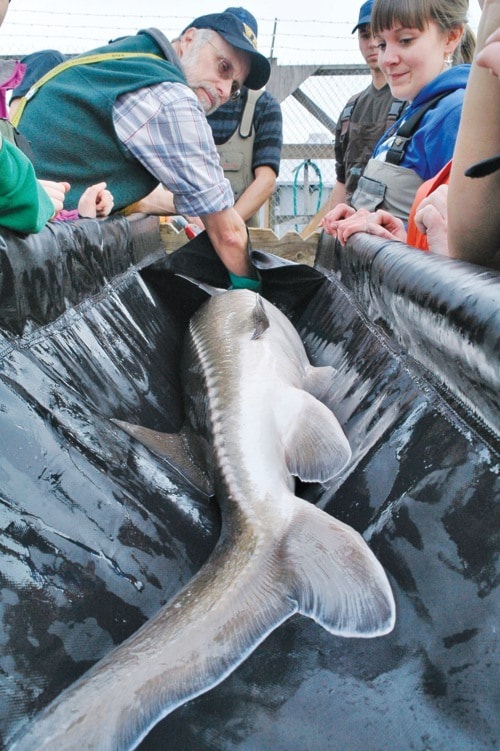Tyra – named after supermodel Tyra Banks – isn’t exactly what you’d call runway material, unless that is, you happen to be a male sturgeon.
She and her two pool buddies Angie, named for Angelina Jolie, and Dottie, because she has a beauty mark, were moved from a pool under an old greenhouse, where they’ve been since about 1988, to a holding tank in Vancouver Island University’s new International Centre for Sturgeon Studies building Wednesday.
The centre opened in October 2011 and has a state-of-the-art freshwater closed containment recirculation system. Populations of smaller fish under study have already been moved there.
It’s never polite to ask a woman’s age or weight, but it might be worth mentioning that Tyra, estimated at 40, is about the same age as her namesake. Each of the three fish tilt the scales at about 91 kilograms and are about 2.5 metres long.
Dottie is pregnant with a belly full of roe, by the way. None of the media and guests invited to witness the move thought to ask how that happens in a tank full of females, but she’ll likely spawn in June.
Moving these big gals took a sizable complement of fisheries and aquaculture students and staff to wrangle each fish into a litter, sedate them, check them over and then carry them to their new home. Sturgeon are ancient fish often referred to as living fossils. Their time on Earth dates back to the Jurassic era, about 250 million years.
“There’s even evidence now that they might go back as far as 300 or 350 million years,” said Gord Edmonson, VIU fisheries and aquaculture technician.
Over that time these gentle giants survived several mass extinctions, including their own near extinction at the hand of humankind in the last century.
The creatures are bottom feeders with big mouths that vacuum up food from river bottoms. They have shark-like tails and cartilage skeletons, but aren’t sharks. Barbels, like big whiskers, around their mouths help them find their way around their aquatic environments.
There are 28 species and subspecies of sturgeon worldwide. Nearly all are threatened or near extinction, so research and conservation is important. Tyra, Dottie and Angie are white sturgeon found in rivers west of the Rocky Mountains.
They breed, depending on environmental conditions, every two to 10 years and can live 150 years or more.
Maybe it was the slightly festive atmosphere or perhaps a sense they have time on their side that endows them with seemingly extraordinary tolerance for their handlers and the moving process.
These fish don’t thrash around violently like a trout. Instead they quickly swing their big tails – something one doesn’t want to be in the path of, these are very strong, massive animals – in wide, steady arcs to let their handlers know they’re not happy. The movement looks almost crocodilian.
“They even have a death roll,” Edmonson said.
Sturgeon are the largest freshwater fish in North America.
Edmonson said the move was a good opportunity to involve students and train them in fish handling techniques.
It’s not every day one gets close to such a large fish, especially a living fossil. There’s something uniquely fascinating, even endearing, about them.
VIU has been involved in sturgeon research since the 1980s. It is the only academic institution in western Canada to have captive white sturgeon brood stock.
Some sturgeon at VIU were rescued from backyard ponds. Tyra spent the first 13 years of her life in one. It’s illegal to keep sturgeon without special permits.
“We acquired two others from the Freshwater Fisheries Society,” Edmonson said. “They’d been taken from poachers about 22 years ago.”
VIU researchers successfully conducted the first captive spawning of Fraser River white sturgeon in 1991.
VIU provided fertilized eggs and fry for the start-up of Target Marine Hatcheries, B.C.’s only commercial white sturgeon culture operation in Sechelt, B.C., in 2000, 2001 and 2004. The company started harvesting caviar and sturgeon meat in 2011.
It took about an hour for the students and staff to have Tyra, Angie and Dottie swimming around in their new home, not far from several smaller tanks teaming with hundreds of their offspring.
“For years, we have housed our eight sturgeon brood stock – fish old enough to spawn – in tanks located inside an old greenhouse,” said Don Tillapaugh, centre director. “The ICSS provides a better, safer and more secure home for the fish in a state-of-the-art facility.”
